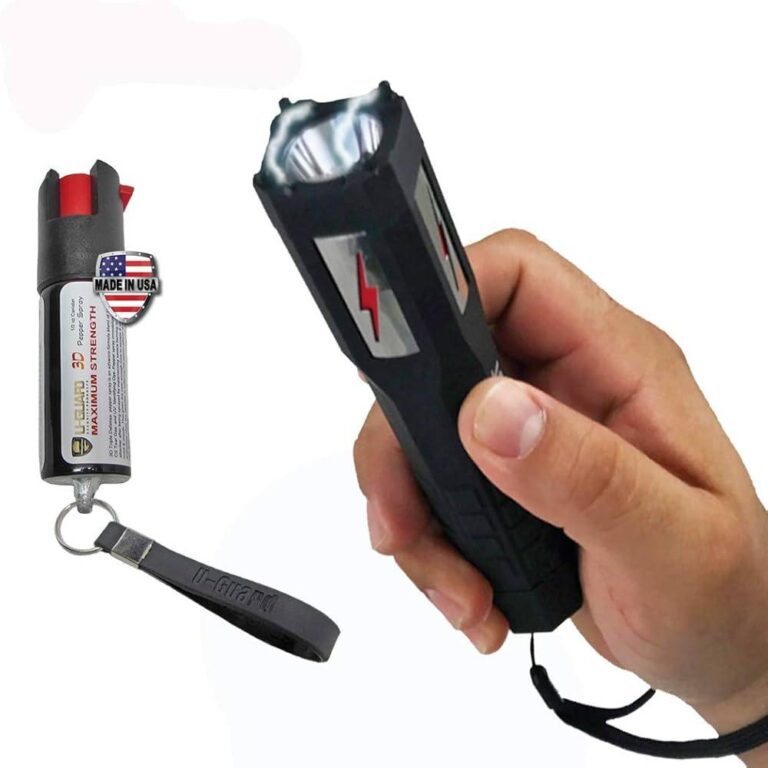Table of Contents
- Comparing Effectiveness and Practicality in Real-World Scenarios
- Understanding the Legal Considerations and Restrictions
- Assessing Portability, Ease of Use, and Maintenance Requirements
- Expert Recommendations for Selecting the Ideal Self-Defense Tool
- The Conclusion
Comparing Effectiveness and Practicality in Real-World Scenarios
In practical self-defense situations, the ability to deploy your tool quickly and effectively can make all the difference. Stun guns offer the advantage of immediate incapacitation by delivering a high-voltage shock that can halt an assailant in their tracks. They are particularly effective in open spaces where maintaining a slight distance is preferable, and their ease of use-simply pressing a button-adds to their appeal under stress. However, stun guns require a direct contact or close proximity to the attacker, which can be a risky maneuver if you’re not confident in your physical skills.
Kubotans, on the other hand, excel in scenarios where discreetness and fine control are crucial. Their compact size and simple design allow for quick concealment and effortless grip. They can be used not only to inflict pain but also to apply pressure on sensitive nerve points, offering a strategic advantage for users trained in pressure-point techniques. Key benefits of kubotans include:
- Ease of carrying due to their small size
- Low reliance on batteries or electronics
- Ability to be used in close-quarters with precise strikes
Understanding the Legal Considerations and Restrictions
Before making a decision between a stun gun and a kubotan, it is crucial to familiarize yourself with the legal landscape surrounding these tools. Laws vary significantly by country and even by state or municipality, often dictating whether possession, carry, and use are permitted. For instance, stun guns may be classified as prohibited weapons in certain jurisdictions, requiring permits or outright banning them. Conversely, kubotans-being small, innocuous-looking keychain weapons-tend to face fewer restrictions but are not entirely exempt from regulation, especially when used with intent to harm. Understanding local statutes helps avoid legal pitfalls that could turn a self-defense measure into a liability.
- Permit requirements: Some areas mandate a license or permit to own or carry a stun gun.
- Usage restrictions: The legality of using these tools varies significantly, particularly in public spaces.
- Transportation laws: Certain regions restrict transporting stun guns across borders or via air travel.
- Age limits: Some jurisdictions impose minimum age requirements for carrying self-defense devices.
It’s also wise to note that even where legal possession is allowed, employing such tools in self-defense situations carries additional legal scrutiny. The concept of reasonable force comes into play, and misuse or excessive force can result in criminal charges or civil lawsuits. Hence, along with compliance, proper training in the ethical and effective use of your chosen self-defense weapon is indispensable. Ensuring you understand applicable laws, coupled with responsible handling, positions you to protect yourself without compromising your legal standing.
Assessing Portability, Ease of Use, and Maintenance Requirements
When weighing your options for a reliable self-defense tool, portability is a crucial factor to consider. Kubotans shine in this category due to their compact size and lightweight design, typically fitting easily on a keychain or in a pocket without adding bulk. Their discreet nature allows for seamless carry without drawing unwanted attention, making them accessible in urgent situations. Stun guns, while also portable, tend to be bulkier and require dedicated storage space, which might be less convenient for everyday carry. Additionally, stun guns often necessitate regular charging or battery replacement, impacting their ease of use over time.
Maintenance demands for both devices also diverge significantly:
- Kubotans: Virtually maintenance-free, they only require occasional cleaning and minimal care to remain effective and durable.
- Stun guns: Require periodic battery checks, charging, and careful handling to ensure functionality, with potential risks of damage if not stored properly.
Choosing between the two means balancing effortless upkeep and seamless portability with functional readiness, tailored to your lifestyle and personal preference.
Expert Recommendations for Selecting the Ideal Self-Defense Tool
When selecting a self-defense tool, understanding your personal environment and comfort with the device is paramount. Experts stress the importance of assessing factors such as legal restrictions, ease of use, and your own physical capabilities. For instance, stun guns require close proximity but deliver an immediate incapacitating shock, making them ideal for those seeking a more direct and impactful defense. In contrast, kubotans offer a discreet, non-lethal option that blends seamlessly into daily life and can be effective for individuals comfortable with applying pressure point techniques or joint locks.
Key considerations recommended by professionals include:
- Familiarity with the tool’s operation to ensure swift and confident deployment under stress.
- The tool’s size and concealability-does it fit naturally into your routine or bag?
- Legal compliance in your jurisdiction to avoid unintended legal consequences.
- Durability and maintenance requirements, since reliability can be lifesaving.
- Your personal comfort level and training-confidence in using the device effectively.
Choosing wisely means balancing these elements to select a defense tool that not only empowers you but also fits seamlessly into your lifestyle and meets local legal standards.
The Conclusion
In the end, selecting the best self-defense tool between a stun gun and a kubotan depends largely on your personal preferences, lifestyle, and comfort with each device. While stun guns offer a powerful, electric deterrent capable of incapacitating an attacker from a short distance, kubotans provide a discreet, non-lethal means of close-quarters defense that relies on technique and precision. Understanding the strengths and limitations of both can help you make an informed choice that aligns with your safety needs and legal considerations. Whichever you choose, investing time in proper training and practicing situational awareness remains the cornerstone of effective personal protection. Stay prepared, stay confident, and prioritize your safety above all.Check Our Other Blogs
- StunGun – Your Trusted Source for Stun Guns, Laws, and Self-Defense Tips
- PepperSprayLaws – Your Trusted Resource for Pepper Spray Information
- StunGunLaws – Your Trusted Guide to Stun Gun Legality and Safety





